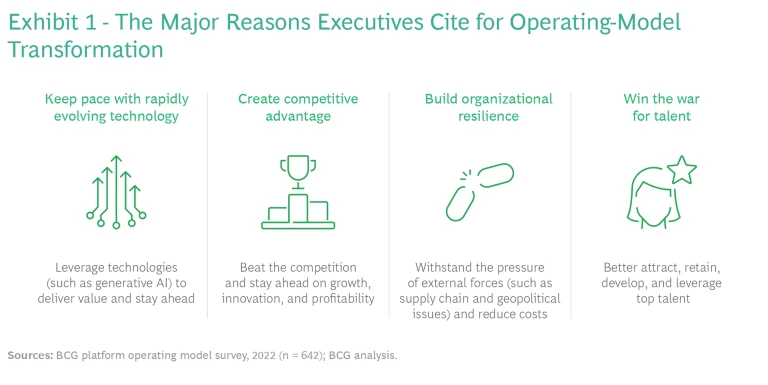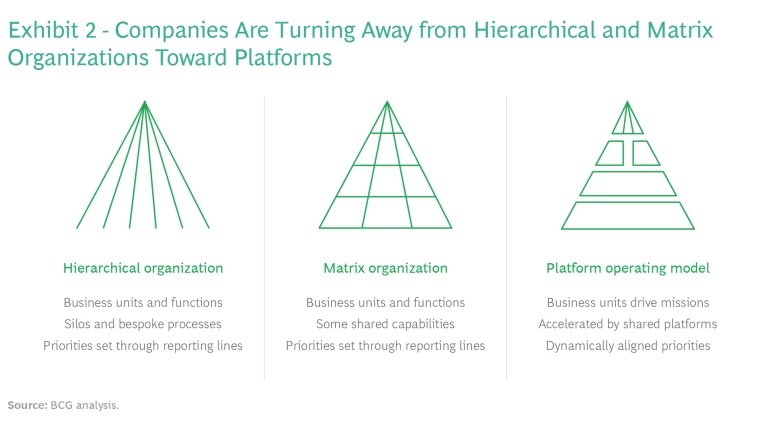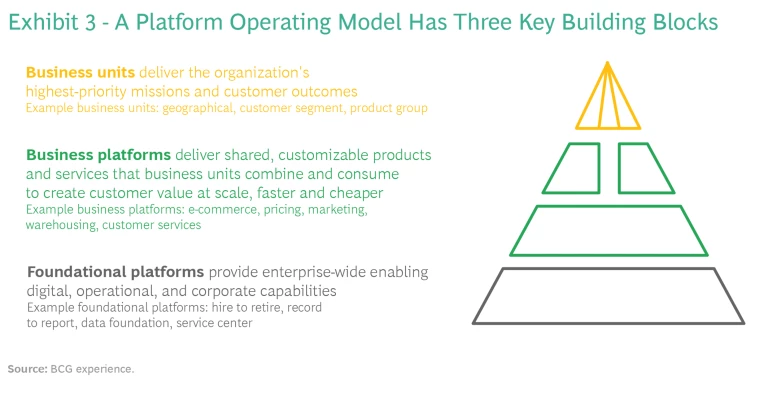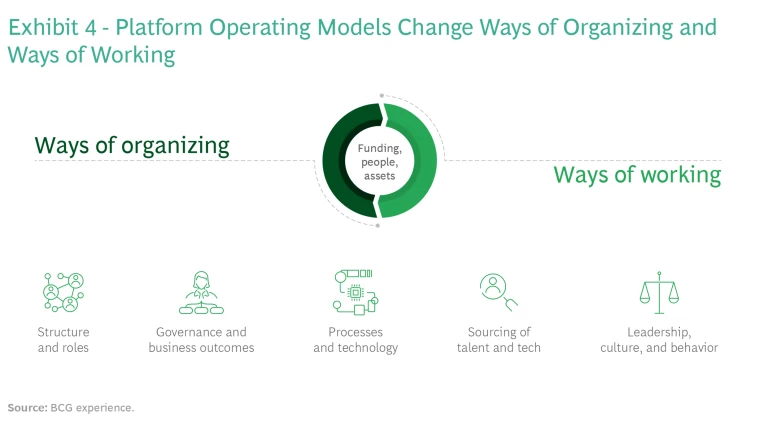Here’s an eye-opening finding: in a BCG survey of industry-leading companies—those with annual revenue growth of more than 10% —two out of three executives saw an urgent need to redesign their operating models. These companies are all top performers. What’s going on?
Post-pandemic and still early in the AI and generative AI (GenAI) revolution, companies are grappling with big questions. How do we stay ahead on growth, innovation, and profitability while withstanding disruption? How do we better attract, retain, develop, and leverage talent? How do we get enterprise-wide value from technology investments? How do we accelerate adoption of new technologies such as GenAI?

Many of the companies we work with are concluding that classic operating-model interventions just won’t move the needle anymore. Rather than attempting yet again to optimize the matrix, they are looking for new solutions. The reasons include the need to drive digitization, build resilience, and win talent. (See Exhibit 1.) These companies are turning to platforms.
The Platform Operating Model
Platforms are shared, enterprise-wide capabilities that deliver customizable products or services that multiple business units combine to create customer value at scale, faster and cheaper. Most companies already use platforms in some form—to ensure that expensive initiatives are not duplicated, for instance, and that resources can be deployed on initiatives that make a difference across the enterprise. Examples of such platforms include a shared technology and infrastructure platform, such as a service desk; a shared data foundation accessible across the enterprise; a global business services function; and other enterprise-wide corporate capabilities.
Lately, though, we are seeing more companies redesign their operating models away from hierarchical and matrix organizations toward platforms. (See Exhibit 2.) Some of these transformations involve an enterprise-wide redesign, including the reimagining of business units to align more closely with customer needs. Others seek more limited changes, such as focusing on one division or function or building a single new platform, which can also be highly beneficial.

The growing number of companies that embrace operating-model redesign expand the sharing of capabilities, bringing together funding, people, and assets to create new, high-value shared foundational platforms. For example, a global retail bank created a customer-onboarding platform that is shared across products, eliminating the need to onboard customers separately for each new account. Auto manufacturers use platforms to create scale when designing and manufacturing different vehicle models. A leading European airline moved to platforms in response to the business shutdown during COVID -19, when digital modernization and automation became fundamental to its vison for customer centricity, efficiency, and sustainability.
Platforms involve much more than moving boxes around the org chart. A platform operating model puts business units, with their firsthand understanding of customer needs, in the driver's seat. Business units and platforms align on priorities dynamically and collaboratively, with the former focused on delivering on the organization’s priority missions and the latter enabling and accelerating delivery. (See Exhibit 3.)

The expanded sharing of capabilities eliminates the following problems:
- Duplication, as small-scale processes within individual functions are replaced with a shared, enterprise-wide platform
- Substandard capabilities, as capabilities that are shared enterprise-wide make a far stronger business case for investment and talent (which loves working on well-funded and broadly used initiatives)
- Silos, handoffs, and burdensome governance, as organizations evolve from traditional matrix management toward simpler structures
The impact on speed, efficiency, and employee satisfaction cannot be overstated. We have seen a two- to fourfold reduction in time to market, cost savings of 15% to 20%, and employee satisfaction ratings of 90% or more.
Platform Pitfalls
Unlocking these benefits requires comprehensively rethinking structure and roles, governance and business outcomes, sourcing of talent and technology, and leadership, culture, and behavior, among other aspects of organizing and working. (See Exhibit 4.) Success is not guaranteed, and there are multiple pitfalls.

Structure and Roles. Too often, companies focus on organizational structure at the expense of governance, leadership, and ways of working. Rigid structures lock talent into fixed teams. Companies fail to establish clear mechanisms for building future-proof competencies into the organization and to adopt company-wide mechanisms for structuring alignment across teams. Managers’ concerns about turf and loss of influence may also need to be overcome.
Governance and Business Outcomes. It’s essential to have clear links between company strategy and work taken on by the platforms. Business units and platforms need to align on what the businesses need the platforms to provide. Failing to shift or connect incentives to desired outcomes can undermine the transition.
Sourcing of Talent and Technology. Companies need clarity on which processes and technologies are truly differentiating, and they should design the organization for the capabilities they want to have rather than the work they need to do now. Failing to include suppliers in the transformation to new ways of working is a common oversight.
Leadership, Culture, and Behavior. Leaders must buy into
future ways of working
and be prepared to change their own ways of working in support of those goals. Companies too often do not acknowledge and deal with misalignments among senior leaders that then hold the transformation back.
Getting It Right
Our survey of industry leaders found that companies that are “very effective” at tackling all aspects of operating-model change are seven times more likely to perform “significantly better than peers.”
To get started, there are two common steps that can be taken individually or in combination: developing an operating-model blueprint and building no-regrets priority platforms.
Developing an Operating-Model Blueprint. Developing a blueprint for the target state typically requires that companies do the following:
- Baseline the current operating model. Management needs a strong working understanding of the organization’s current structure with respect to how functions and processes interact and how they provide specific services to one another. Identifying the organization's strengths, challenges, and pain points will shape the direction and extent of the transformation.
- Build tight alignment. Senior leaders and the project team must agree on the scope of the transformation and key principles of the platform operating model, such as fewer is better (investing in fewer at-scale platforms with greater sharing of capabilities across business units) and the need for autonomy (setting up platforms to deliver end-to-end outcomes for the business units they serve).
- Define the purpose of the platforms. Companies should decide how the platforms best serve the organization's mission, which will shape the primary organizing logic (regional, product aligned, or segment oriented, for example) and the changes needed to align the new setup with P&L accountability. Factors for consideration include drawing the reporting lines for business units and platforms (when one platform serves multiple units) and designing a governance structure that ensures ongoing alignment on platform priorities.
- Develop a roadmap for implementation. Key choices need to be made on how to sequence the changes that are part of the transformation. As with any change program, accountabilities, timelines, and KPIs are essential for focusing the effort and monitoring progress.
Building No-Regrets Priority Platforms. Many companies move straight to building a few platforms without first developing an enterprise-wide blueprint. These early platforms are designed to rapidly deliver value, which helps fund the transformation and demonstrate that the new operating model works. Early platforms are also test-and-learn vehicles. Managers should be prepared to experiment and adjust course based on what they learn.
The ideal characteristics of early platforms include the following:
- They can be shared by multiple business units or product lines, and multiple businesses have a high degree of willingness to use them.
- They bring together a strategically valuable capability that is dispersed across different parts of the enterprise, so it can be widely accessed and easily modified (making GenAI available across the organization, for example).
- They are a clear part of the future blueprint.
Widespread organizational access to critical and difficult-to-build capabilities such as data , AI , and GenAI will only become more important as technology advances and competitors become faster and more nimble. Making the transition to platforms now, while there is time to test, learn, and get it right, will give early movers an organizational advantage going forward.












